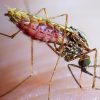- Empty cart.
- Continue Shopping
The Importance of Flea and Tick Prevention for Pets

Flea and tick prevention is not just a seasonal concern; it’s a year-round commitment that is crucial for the health and well-being of your pets. These tiny parasites can cause a range of problems, from skin irritations to serious diseases.
The Health Risks Posed by Fleas and Ticks
Fleas: More Than Just Itchy Bites
While fleas are best known for causing itchy, uncomfortable bites, their impact goes beyond mere irritation. Fleas can transmit tapeworms and are responsible for conditions like flea allergy dermatitis, which can lead to severe itching and skin infections.
Ticks: Carriers of Diseases
Ticks are even more dangerous, as they can transmit various diseases, including Lyme disease and Rocky Mountain spotted fever. These illnesses can have severe implications for your pet’s health, affecting their joints, nervous system, and overall well-being.
Effective Prevention Strategies
Topical Treatments
Topical flea and tick preventatives are applied directly to the pet’s skin and offer a convenient way to keep these parasites at bay. These treatments are generally effective for about a month and are available in various formulations for both dogs and cats.
Oral Medications
Oral flea and tick preventatives come in the form of chewable tablets and offer another effective method of control. These medications can provide up to 12 weeks of protection, depending on the brand and formulation.
Collars and Shampoos
Flea and tick collars offer long-lasting protection and are an excellent option for pets who don’t tolerate topical or oral treatments well. Special shampoos designed to kill fleas and ticks can also be used but generally offer shorter-term protection.
Environmental Control
Regular Cleaning
Regularly cleaning your home, especially areas where your pet frequently resides, can help control flea and tick populations. Vacuuming carpets, washing pet bedding, and cleaning upholstery can go a long way in prevention.
Yard Maintenance
Keeping your yard clean and well-maintained can also reduce the likelihood of flea and tick infestations. Trim tall grass, remove leaf litter, and consider using pet-safe yard sprays to kill fleas and ticks at their source.
Veterinary Consultation
It’s essential to consult your veterinarian for personalized advice tailored to your pet’s specific needs. Factors like age, weight, and pre-existing health conditions can influence the choice of flea and tick prevention methods.
Conclusion
Flea and tick prevention is a critical aspect of pet care that should not be overlooked. These parasites pose significant health risks and can severely impact the quality of life for your furry friends. By employing effective prevention strategies and consulting with your veterinarian, you can protect your pets from the discomfort and diseases that fleas and ticks can bring.








